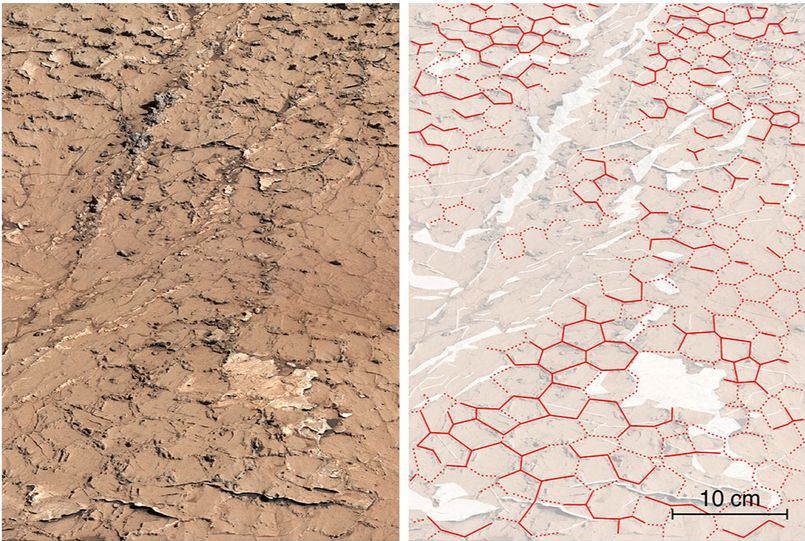
There were wet and dry cycles on Mars, just like on Earth: Curiosity helps make new discovery
The Curiosity rover has discovered ancient mud cracks formed by repeated wet and dry cycles. This is the first concrete evidence on the red planet of such cycles, similar to those of early Earth. Scientists believe that the conditions under which these cracks were created could have been favorable for the formation of microbial life on Mars.
In a new study, scientists focused on 3.6-billion-year-old rocks in Gale Crater on Mars. There, Curiosity discovered salt deposits that look like a hexagonal pattern, and studied samples taken from the transition zone between the clay layer and the salt mineral layer. This indicates a period when long dry periods began to predominate, as a result of which lakes and rivers began to dry up on Mars.
The scientists found that when the mud at the bottom of Mount Sharp on Mars dried once, the reappearance of water caused the mud to soften, forming a hexagonal pattern.
“When the lake dries up, the mud cracks, and when it fills up again, the cracks stick together. This is the first concrete evidence that Mars had a cyclical climate,” said William Rapin, lead author of the study, from France’s CHRS Research Center.
Signs of cyclic changes between wet and dry conditions can also be seen in later sedimentary layers, indicating the duration of these periods. Scientists have obtained new evidence that the ancient climate of Mars had periods of alternating wet and dry cycles similar to Earth.

Studying these mud cracks could be of great importance in understanding the processes that may have contributed to the origin of life. Although water is necessary for life to exist, a balance between moisture and dryness is also necessary. Regularly repeating wet and dry seasons, like on Earth, could have provided the conditions necessary for life to arise on Mars.
Curiosity has previously detected organic compounds thought to be building blocks of life on Mars and could be another piece of the puzzle. But these structures require the right conditions to become a sign of life.
Finding such an ancient landscape would be impossible on Earth where tectonic plates are constantly in motion and rearrange the planet's surface, erasing such remnants of past eras.
“We are lucky to have a planet like Mars nearby, which holds the memory of natural processes that could have contributed to the emergence of life,” Rapin said.
The Curiosity rover began its mission on Mars in August 2012, and it continues to conduct research and provide scientists with new knowledge about Mars, providing a deeper understanding of the history of this planet and its potential for habitation.
- Related News
- Wheel of Death: new method will help astronauts stay fit in low gravity
- Due to anomalies of Orion spacecraft, lunar exploration program may be delayed for years։ NASA
- TAO Observatory: World's highest telescope to study evolution of galaxies and exoplanets
- Powerful M9.5 solar flare causes radio blackout in Pacific Ocean
- What will happen to the Earth if the Moon disappears?
- Key to conquering the Red Planet: Why is NASA studying solar storms on Mars?
- Most read
month
week
day
- Digital Julfa Network is launching a pan-Armenian centre in the metaverse, on the Fastexverse virtual platform 988
- Xiaomi unveils exclusive Redmi Note 13 Pro+ dedicated to Messi and Argentina national team 868
- Sparkles: Boston Dynamics unveils a furry robot dog that can dance (video) 831
- Is there a ninth planet in the solar system? Scientists find new evidence 701
- What will happen to the Earth if the Moon disappears? 690
- Smartphone catches fire in child's hand in Russia 675
- How to understand how protected a smartphone is from water and dust? 668
- iPhone 16 may get colored matte glass back panel, 7 colors 668
- Internet 500 times faster than 5G tested in Japan: It allows to transfer five movies in HD resolution in one second 662
- World's largest 3D printer was created in USL It prints 29 meter-long structures 655
- Archive
